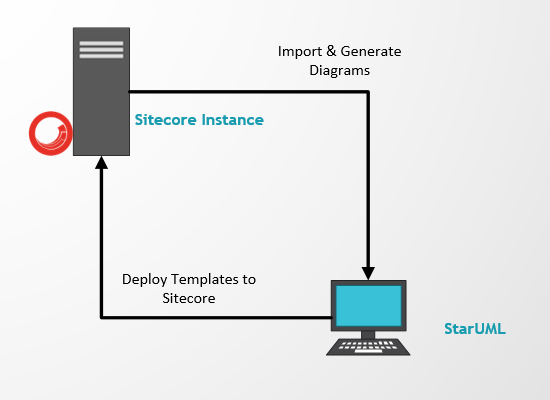How it Works
The functionality of SitecoreUML is provided by a two-way integration between Sitecore and StarUML, the editor for the UML diagrams and models.
StarUML
StarUML is one of the most popular modeling and diagramming tools on the market. It is important to know that StarUML is not just a diagramming tool, like Microsoft Visio, but also a modeling tool, wherein the model can be represented beyond the scope of the diagrams, alone. In other words, a diagram is a model but a model is not a diagram. Conceptually speaking, a diagram is a type of visual model. SitecoreUML leverages both the diagramming and modeling aspects of StarUML.
Components of SitecoreUML
SitecoreUML is comprised of two components:
- Sitecore Module
- StarUML Extension
The Sitecore Module's main purpose is to add the SitecoreUML service to the Sitecore site. SitecoreUML uses this service in order to deploy templates to and request template data from Sitecore. There are some additional features, as described in the chapter on JSON Tools, however they are typically for more advanced users looking to customize or extend SitecoreUML.
The main component of SitecoreUML is the StarUML extension. This component extends the native StarUML interface and provides support for configuring Preferences, one-click deployment to Sitecore and one-click import from Sitecore. As with the Sitecore module, there are some additional features that are for more advanced users looking to customize or extend SitecoreUML. You can read about these features in the JSON Tools chapter.
Import & Export Architecture
SitecoreUML's import and export logic is pretty straight-forward. When you import, you are requesting data from the Sitecore instance. The retrieved data is then used to auto-generate your diagrams and models in Star UML. In contrast, when you deploy, you are sending data from StarUML to Sitecore, where it is then used to auto-generate templates and template folders.

Serialization and Transmission
It's time to share the "secret sauce," as it were. When data is transferred there is a transmission source and a target. The transmission source isn't where the command to send or receive data was executed, but rather the location where the data to be transferred is stored. In SitecoreUML, if the Sitecore instance is the source then StarUML is the target, and vice versa. Whether you are deploying or importing your data, the first step is serialization.
SitecoreUML uses a custom JSON structure for transferring data. Whether you are serializing existing Sitecore templates or UML diagrams and models, the resulting JSON structure is the same. Once the data has been serialized, it is transferred to the target, where it is subsequently deserialized into the target format - either Sitecore templates or UML diagrams and models.